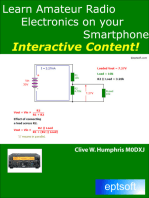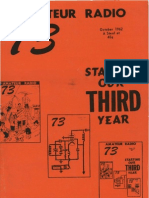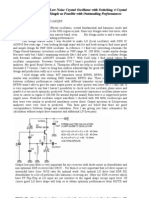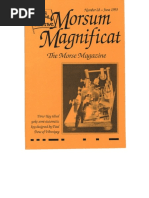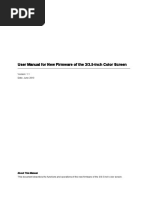A Simple Arduino-Driven Direct Digital Synthesiser Project: Gets Worry It's
Uploaded by
mastelecentroA Simple Arduino-Driven Direct Digital Synthesiser Project: Gets Worry It's
Uploaded by
mastelecentro'" Carrying on the Practical Way with Tex Swann G1TEX
• E-Mail: tex@pwpublishing.ltd.uk
ASimple Arduino-
driven Direct Digital
Synthesiser Project
Our Technical Editor gets involved in creating a resistor was a difficulty in knowing the
precise frequency. So began a search for
simple HF DDS local oscillator project. Don't worry; an alternative oscillator. One option I found
was, in display and frequency terms, ideal.
he assures us it's not that difficult! That option is the Arduino-based direct
digital synthesis (DDS) oscillator from
Kanga-Products, website below, which
was created by Paul Darlington MOXPD,
en I started to put website below, slightly modified to URL below.
W ogether the slngle-
band double sideband
DSB) transceiver
project described
in PW back in the September 2014
issue, I paid less attention to the type
of local oscillator to use. I'd initially
cover 7.0 to 7.2MHz. The Portland
oscillator originally used a single
variable resistor to cover the band
but I found it rather difficult to tune
precisely. So this was changed to a
multi-turn potentiometer, which gave
much better control of frequency.
www.kanga-products.co.uk
http://mOxpd.blogspot.co.uk
A DDS 'oscillator' is in practice not
a true oscillator because it produces
a repetitive waveform from a series
of discrete steps, rather than using a
feedback mechanism to create an output.
used a Spectrum Communications www.spectrumcomms.co.uk The semiconductor firm Analog Devices
Portland oscillator project, see One side effect of this change of control produces a variety of these DDS chips,
28 PractJcal Wireless May 2016
which with a little programming can create to 30MHz as a signal generator plus the bands. Each one has indications of band
signal frequencies well up into the higher 136 and 475kHz bands along with the limits. I chose not to provide any of the
HF bands. 1.8, 3.5, 7, 1O, 14, 18, 21, 24 and 28MHz 5MHz spot frequencies.
Sourcing the Boards
There's an AD9850 in the Kanga project,
which proved ideal for my requirements
in terms of display and stability
requirements. On the downside, it needed
both the DDS project 'shield' and a full
Arduino, such as the Arduino UNO, to
complete. I decided that, after the success
of my Arduino RF power meter project
(published in PW December 2015) , I felt
sufficiently confident to tackle creating my
own version of the DDS project. I therefore
started looking for a suitable (cheaper)
alternative for the two boards.
On a certain internet 'shopping' site,
I found two suitably complete boards
fully built. It turned out that there are
two versions of the DDS board, Fig. 1,
and a variety of Arduino 'clones' at quite
reasonable prices, Fig. 2. Flushed with
some progress, I set about researching
how others had approached the problems
of creating a DDS signal generator, using
the AD9850 of which I'd found the two Fig. 1: There appear to be two main versions of the AD9850 DDS board available; here they are side
boards. by side. Each has the same pins available and they seem to be electrically similar - see the text for
Although differing physically, the two comments about each.
boards appear to be electrically the same,
meaning that they could be used with
the same controlling software. Some
similar boards but with AD9851 ICs are
also available. These tend to be more
expensive, offering only a greater range of
frequencies. Using these also meant some
minor changes would have to be made to
the software.
Prototype Time
The heading photograph shows my first
working prototype, which still needs a
little more work on it to put into a fully
working transceiver but is otherwise fully
functional. A rotary controller is used to
set the frequency or band of operation. A
push-switch on the rotary controller allows
a faster tuning rate. In combination with
a separate switch, tuning steps of 5, 50,
100 or 1OOOHz are possible. So with 40
steps per revolution of the rotary controller,
various fast or fine tuning rates are
available. A separate switch again gives a
tuning rate of 1OOkHz per step except in
bands that are narrow.
I initially created the project for a single
band but then I wondered what else I
• 4 ..
could use it for because there was still
plenty of space left in the programming
memory of the Arduino clone. I decided to
make it multi-band, adding in a general- Fig 2: Tex also found two main versions of this Arduino clone available; either will work with his
purpose signal generator mode too. As suggested program. Note that the version on the left Is slightly more difficult to Identify the various
the project now stands, it covers 1OOkHz pins and has no on-board use serial interface.
May 2016 Practical Wireless 29
World of VHF incorporating VHF DXer with Tim Kirby G4VXE
Willowside, Bow Bank, Longworth, Oxfordshire OX13 5ER
• E-mail: tim@g4vxe.com • Twitter: g4vxe • Facebook: www.facebook.com/worldofvhf
144MHz Activity
notification message (and optionally an
alarm sound or vibration) on their Android
device. Tapping the notification icon will
show a handy overview of all countries
(prefixes) currently active. The overview is
grouped by VHF band (2, 4 and 6m) and
Periods, TV from by propagation mode (Es/TEP and Au).
A red notification icon shows if there is
any Es, TEP or aurora on any of the VHF
bands''. The program also facilitates the
display of DX Cluster spots for the band in
ISS and More question. Unfortunately, I've not been able
to test this myself because I use Apple iOS
devices. Try it out and let me know how
you get on. You can download the app,
currently free, from: https://play.google.
Once again Tim Kirby G4VXE has lots to report about com/store/apps/ details?id =net. gooddx.
es sense
all aspects of VHF operating, including an interesting
The Gm Band
smartphone app, band reports, microwaves and satellite I was delighted to hear from Ron Adam
GM41LS (Elgin). Ron was one of the first
activity. stations that I ever worked via aurora and
many years later, is still taking advantage
of the mode. During the event on March
6th, Ron had a fascinating time. After
yn Leach GWBJLY is is a DVB-S signal, on 11. 005GHz as far as working stations on the higher bands
L promoting some 144MHz
SSB activity periods. In an
effort to increase activity,
he suggests three 2m SSB
activity periods each week throughout
the yea r, commencing on Monday the
March 28th. These will take place on
the receiver is concerned and the symbol
rate=2000 and FEC= 1/2. The signals from
the !SS differ from the DVB-S specification
in that they don't contain an SID but you
can put the parameters in manually:
VP/0=256, AP/0=257, PCR=256 and
PMT=258. Anyway, having locked the
earlier in the evening, Ron came back
into the shack around 2220UTC and
found TF3ML on so.11 OM Hz calling ca
DX on a beam heading of around 3S0°.
SSA reports were exchanged. Ron then
decided to call ca on S0.090MHz and
at 2230 was called by BM6GJL (Taiwan).
Monday and Friday evenings between receiver to the /SS, what did I see? Well, Ron says that he was surprised to say
2000 and 2200 local time and on outside of school contacts the picture is the least! Was this aurora plus some
Wednesday mornings between 1000 all black. The camera they use is battery other mode? It must have been - and
and 1200 local time. powered and can't be left on between I'm suspecting it was around sunrise in
What a great idea. Do try to come on broadcasts" . Simon kindly included a Taiwan. Ron awaits confirmation of the
if you can, even if you only have a vertical picture of the setup. Colin G4KLB has contact and if it is confirmed, then what
antenna or a halo, or perhaps you can go also been working on receiving the TV a truly amazing one. BM6GJL does have
portable. signals and has put an interesting video a SOMH z EME capable system so will be
on YouTube that is well worth a look: well placed to exploit any openings. Other
Receiving TV from the ISS https://youtu.be/9keVA21 DPBc contacts included LA9DLR (JOS9) and
I've mentioned receiving voice and packet DFSLa (J044) as well as GM81EM (1078),
transmissions from the International Space EsSense - VHF Propagation App for GM4UYE (1086) and GMOLVI (1086).
Station (ISS) in this column on many Android
occasions but I believe this is the first time Jim Edgar GM4FVM alerted me to the The 4m Band
that I have had a report about receiving EsSense app for Android smartphones Simon G6AHX tried out his new 70MHz
television from the ISS. Let Simon and tablets. The app has been written by transverter for the first time during the
Evans G6AHX take up the story. "Much Allard PE1 NWL of DXrobot fame . This RSGB Cumulative on February 28th, albeit
encouraged by a friend, Ian GBXZD, I have is the description of the program from using a vertical antenna. Simon's best DX
been trying to receive the Ham TV signal the Google Play store, "Targeted (prefix- was G4RFR (1090) but he was also very
from the /SS. Today I have succeeded! based) E-skip, TEP and Aurora alerts for pleased to work GWOGEI (1072). During
I've used a 60cm prime focus dish with a the VHF ham radio operator. From the the aurora on March 6th, Ron GM41LS
homemade left-hand circular helix antenna DXrobot. VHF DX spots, posted by radio worked G3UKV (1 082).
for 2.395GHz. The signals from the /SS are amateurs to the worldwide DX cluster, are Jim GM4FVM says, "The usual 4m
thought to be right-hand circular, which constantly monitored and analysed by the meteor activity continues with regulars
is fine after reflection off the dish. I fed gooddx.net server. When a Sporadic E, SP9HWY and OZ1JXY worked in the last
the received signal into an Arabsat LNB, TEP or Aurora opening is detected, the month. A new one for me on meteor
which has a local oscillator at 3.650GHz. DXrobot will send targeted push messages scatter (MS) was a QSO on March 12th
After the LNB, the signal passed to my only to users in relevant countries with Tomas EA2BCJ, which was also a
satellite receiver and spectrum analyser on (countries where the opening actually new square on 4m (IN91 1581km). That
1.255GHz. The LNB puts Ham TY, which occurs). These users will then receive a confirmed my belief that MS QSOs are
30 Practical Wireless May 2016
More Information
Construction
The prototype shown in this article was built For a copy of the Arduino sketch and the rotary encoder library involved , e-mail:
up on stripboard and uses the 5V supply tex@pwpublishing.ltd.uk with "Arduino DDS" as the subject text.
from the separate USS-to-serial adapter A pre-programmed Arduino clone may be obtained, along with a small number
because the small Arduino board doesn't of minimal kits available at cost. These are kits that have all the 'important' and
have its own supply. As mentioned above, unusual parts included, leaving you to provide some easily available other bits.
I've come across two variants of the DDS E-mail as above, for availability and more information about costs covering
board. The one shown here is markedly parts and P&P.
cheaper for some obscure reason but they
both work the same way. Having said that,
this one is a little more difficult to integrate
onto stripboard. also be available from your favourite This chance find allowed me to create a
The DDS controller I chose has three internet 'shop'. Depending on the source, 4:1 step-down transformer with a separate
rows of pins set out as one double row of you may need to check the address that output winding. Connecting a transformer
seven pins and a single row of seven at the it's set to. The photograph of Fig. 4 shows to the DDS output requires a small 0.1µF
far end. Luckily, as only a few of the pins the three solder 'bridges' that, when capacitor to isolate its DC level from the
of the outer of the double row are needed, made, set the port address to hexadecimal transformer's input winding. You could
I could ignore the inner row completely 20 (or 32 in decimal). Solder pad bridges also create a simple bifilar-wound toroidal
when putting sockets onto the stripboard. have hexadecimal weighting of 4 , 2 or 1, transformer to do the same thing.
Because the clone Arduino board I built giving eight possible addresses for control The RF output available from this
this project with is physically small and has of the display. project is slightly over 1mW (250mV) at
no on-board serial programming interface, Initially, I had assumed that the DDS the lower frequencies, dropping to around
there are contacts on all four sides of the synthesiser had an output impedance 500µW (150mV) at 30MHz. If a more
PCB. I started with this version because I of 50Q for the lowpass filtered output. defined output is needed for your purpose,
was still waiting for the other ones to turn However, after some research, there's an then an ALC circuit would be needed.
up. indication from several documents that However, that's beyond this present
The initial board also has rather a the output impedance is more likely to be project but may be the subject of a future
cramped pin annotation layout and care 200Q. The alternative, unfiltered output article.
is needed when identifying them. This available on the two pins shown in Fig. So, there you have it, a simple signal
will be replaced in the final version with a 3 seems to have an output impedance generator that covers up to 30MHz,
slightly more expensive clone that has only of 1OOQ. This would matter less if I only suitable either as a general purpose unit
two rows of pins as well as its own USS wanted a local oscillator output but for use or as signal source for homebrew direct
programming port and regulator. as a general-purpose signal generator, a conversion receivers or CW transmitters.
50Q output would be more suitable. See the separate panel to obtain the
The Converter PCB Luckily, some months earlier I'd come source files or some of the bits I have
Turning now to the serial-to-parallel across some small pulse transformers available.
converter PCB for the display, this should with three apparently identical windings. 0
Fig. 4: Looking at the back of the high speed serial to parallel interface board for the display that's mounted directly onto the display. The jumper at the
left, marked 'LED' controls the backlight. The address setting bridges may be identified under the blue contrast setting potentiometer - see the text for
comments.
May 2016 Practical Wireless 31
You might also like
- Bush, Kate - Running Up That Hill-SheetMusicHaven83% (6)Bush, Kate - Running Up That Hill-SheetMusicHaven6 pages
- (2nd Line - Clarinet Transcriptions ListNo ratings yet(2nd Line - Clarinet Transcriptions List85 pages
- Where Does NBDP Fit in GMDSS and How To Use ItNo ratings yetWhere Does NBDP Fit in GMDSS and How To Use It23 pages
- An Arduino Uno DDS AF RF Signal Generator PDFNo ratings yetAn Arduino Uno DDS AF RF Signal Generator PDF3 pages
- A High-Performance Homebrew TransceiverNo ratings yetA High-Performance Homebrew Transceiver35 pages
- An-749 Broadband Transformers and Power Combining Techniques For RF100% (2)An-749 Broadband Transformers and Power Combining Techniques For RF10 pages
- Low Cost HF Antennas & Accessories: Phil Salas - AD5XNo ratings yetLow Cost HF Antennas & Accessories: Phil Salas - AD5X42 pages
- 80 Meter VFO: Paul R. Jorgenson KE7HR NSS 39382FE100% (3)80 Meter VFO: Paul R. Jorgenson KE7HR NSS 39382FE2 pages
- Arm Case-Study: The Raspberry Pi: Razvan Bogdan Microprocessor Systems100% (2)Arm Case-Study: The Raspberry Pi: Razvan Bogdan Microprocessor Systems115 pages
- ESP-WROOM-02: What Is The "Internet of Things"?100% (2)ESP-WROOM-02: What Is The "Internet of Things"?7 pages
- Icom IC-R1:: The Ultimate Review, Modification & Restoration GuideNo ratings yetIcom IC-R1:: The Ultimate Review, Modification & Restoration Guide29 pages
- Txtopper QRP Amp PCB Layout: Viewed From Component Side of The BoardNo ratings yetTxtopper QRP Amp PCB Layout: Viewed From Component Side of The Board1 page
- Morsum Magnificat The Original Morse Magazine-MM28No ratings yetMorsum Magnificat The Original Morse Magazine-MM2852 pages
- GQRP Component Data Book: How It All WorksNo ratings yetGQRP Component Data Book: How It All Works27 pages
- Direct Conversion Radio Transceivers For Digital Communications100% (2)Direct Conversion Radio Transceivers For Digital Communications12 pages
- Very High Performance Image Rejecting Direct Conversion Receivers100% (1)Very High Performance Image Rejecting Direct Conversion Receivers37 pages
- Low Jitter Frequency Reference: The NCO As A Stable, Accurate SynthesizerNo ratings yetLow Jitter Frequency Reference: The NCO As A Stable, Accurate Synthesizer4 pages
- Broadcasting: Outline: - Radio and Television History - Broadcasting Policy100% (1)Broadcasting: Outline: - Radio and Television History - Broadcasting Policy7 pages
- Application Note Introduction To Infineons Simulation Models For Power MOSFETsNo ratings yetApplication Note Introduction To Infineons Simulation Models For Power MOSFETs12 pages
- Lex2 - Microx - Channel Box Sa HRG (2a02274, Rev B)No ratings yetLex2 - Microx - Channel Box Sa HRG (2a02274, Rev B)46 pages
- Channel Box: Take Your Branding To A Whole New LevelNo ratings yetChannel Box: Take Your Branding To A Whole New Level2 pages
- 2019 WhatisTV Redefining V4 TV MediArXiv PrePrintsNo ratings yet2019 WhatisTV Redefining V4 TV MediArXiv PrePrints26 pages
- Carmina Burana: Fortuna Imperatrix MundiNo ratings yetCarmina Burana: Fortuna Imperatrix Mundi20 pages
- XXXX Project Microwave Quality Inspection Report V2.1No ratings yetXXXX Project Microwave Quality Inspection Report V2.124 pages
- Learning Activity Sheet in Mapeh Grade 8 Quarter 4 Week 5-6 (June 22-28, 2021)No ratings yetLearning Activity Sheet in Mapeh Grade 8 Quarter 4 Week 5-6 (June 22-28, 2021)9 pages
- Date: June 2013: About About About About This This This This Manual Manual Manual ManualNo ratings yetDate: June 2013: About About About About This This This This Manual Manual Manual Manual62 pages
- A MEMS Ultrasonic Transducer For Monitoring of Steel StructuresNo ratings yetA MEMS Ultrasonic Transducer For Monitoring of Steel Structures9 pages
- A Comparative Study of 5-Level and 7-Level Multilevel Inverter Connected To The GridNo ratings yetA Comparative Study of 5-Level and 7-Level Multilevel Inverter Connected To The Grid29 pages
- Musical Fragility A Phenomenological Examination: Nomi EpsteinNo ratings yetMusical Fragility A Phenomenological Examination: Nomi Epstein14 pages
- Learn Amateur Radio Electronics on Your SmartphoneFrom EverandLearn Amateur Radio Electronics on Your Smartphone
- An-749 Broadband Transformers and Power Combining Techniques For RFAn-749 Broadband Transformers and Power Combining Techniques For RF
- Low Cost HF Antennas & Accessories: Phil Salas - AD5XLow Cost HF Antennas & Accessories: Phil Salas - AD5X
- Arm Case-Study: The Raspberry Pi: Razvan Bogdan Microprocessor SystemsArm Case-Study: The Raspberry Pi: Razvan Bogdan Microprocessor Systems
- Icom IC-R1:: The Ultimate Review, Modification & Restoration GuideIcom IC-R1:: The Ultimate Review, Modification & Restoration Guide
- Txtopper QRP Amp PCB Layout: Viewed From Component Side of The BoardTxtopper QRP Amp PCB Layout: Viewed From Component Side of The Board
- Morsum Magnificat The Original Morse Magazine-MM28Morsum Magnificat The Original Morse Magazine-MM28
- Direct Conversion Radio Transceivers For Digital CommunicationsDirect Conversion Radio Transceivers For Digital Communications
- Very High Performance Image Rejecting Direct Conversion ReceiversVery High Performance Image Rejecting Direct Conversion Receivers
- Low Jitter Frequency Reference: The NCO As A Stable, Accurate SynthesizerLow Jitter Frequency Reference: The NCO As A Stable, Accurate Synthesizer
- Broadcasting: Outline: - Radio and Television History - Broadcasting PolicyBroadcasting: Outline: - Radio and Television History - Broadcasting Policy
- Application Note Introduction To Infineons Simulation Models For Power MOSFETsApplication Note Introduction To Infineons Simulation Models For Power MOSFETs
- Lex2 - Microx - Channel Box Sa HRG (2a02274, Rev B)Lex2 - Microx - Channel Box Sa HRG (2a02274, Rev B)
- Channel Box: Take Your Branding To A Whole New LevelChannel Box: Take Your Branding To A Whole New Level
- 2019 WhatisTV Redefining V4 TV MediArXiv PrePrints2019 WhatisTV Redefining V4 TV MediArXiv PrePrints
- XXXX Project Microwave Quality Inspection Report V2.1XXXX Project Microwave Quality Inspection Report V2.1
- Learning Activity Sheet in Mapeh Grade 8 Quarter 4 Week 5-6 (June 22-28, 2021)Learning Activity Sheet in Mapeh Grade 8 Quarter 4 Week 5-6 (June 22-28, 2021)
- Date: June 2013: About About About About This This This This Manual Manual Manual ManualDate: June 2013: About About About About This This This This Manual Manual Manual Manual
- A MEMS Ultrasonic Transducer For Monitoring of Steel StructuresA MEMS Ultrasonic Transducer For Monitoring of Steel Structures
- A Comparative Study of 5-Level and 7-Level Multilevel Inverter Connected To The GridA Comparative Study of 5-Level and 7-Level Multilevel Inverter Connected To The Grid
- Musical Fragility A Phenomenological Examination: Nomi EpsteinMusical Fragility A Phenomenological Examination: Nomi Epstein











